Ohio is a stunning nation with a numerous variety of climates that may make it hard to locate trees to be able to thrive in your area. With so many alternatives to select from, it is able to be tough to realize which timber are the satisfactory fit on your specific wishes. Whether you’re searching out a colour tree in your outdoor, a tree to line your road, or a tree to your business belongings, this manual has you protected. In this post, we are able to be sharing the pinnacle 10 bushes which can be properly-applicable for Ohio’s climate. These timber were cautiously selected based on their sturdiness, splendor, and ability to thrive in Ohio’s particular surroundings. Read on to find out the correct tree for your house that will offer splendor, colour, and fee for future years.
Introduction to Ohio’s climate and its impact on tree increase
Ohio’s weather has a tremendous impact on the kinds of trees that thrive in the location. Located within the Midwestern United States, Ohio reports a numerous range of climate situations throughout the 12 months. From warm and humid summers to cold and snowy winters, the weather provides specific challenges for tree increase and survival.
During the summer time months, Ohio can revel in high temperatures and excessive humidity, growing an surroundings that demands bushes able to withstanding warmth stress. On the other hand, winters in Ohio may be harsh, with freezing temperatures and heavy snowfall. These situations require timber which might be resilient to cold temperatures and can resist the weight of snow on their branches.
Additionally, Ohio’s various topography and soil composition similarly affect tree increase. The nation encompasses the entirety from flat plains to rolling hills, impacting elements including drainage, soil fertility, and moisture retention. Certain timber are higher applicable to those various landscapes and soil situations.
Despite those challenges, Ohio is domestic to a big selection of tree species that have tailored and thrived in its weather. From majestic o.K. And maples to resilient pines and spruces, there is a diverse selection of bushes that can not only survive however flourish in Ohio’s climate.
In this final manual, we are able to discover the pinnacle 10 bushes which might be nicely-perfect for Ohio’s weather. Whether you’re a property owner looking to decorate your panorama or a professional landscaper searching for recommendation, this complete manual will offer valuable insights and tips for choosing the precise timber.
By information Ohio’s climate and its impact on tree boom, you may be prepared with the understanding to make knowledgeable decisions on the subject of selecting trees on the way to thrive on this area. So, permit’s dive in and find out the mind-blowing bushes that are best suited for Ohio’s specific climate!
Factors to do not forget whilst selecting timber for Ohio’s climate
When choosing trees for Ohio’s climate, there are numerous vital factors to keep in mind. The state of Ohio stories a various variety of climate conditions, which include hot summers, bloodless winters, and moderate rainfall all through the year. These factors play a critical role in determining which trees will thrive in this region.
Firstly, it’s far crucial to remember the hardiness sector of the unique region in Ohio in which the tree can be planted. Ohio is split into several hardiness zones, ranging from region five inside the north to sector 7 in the south. Each quarter has its own specific climate traits and temperature degrees, which must be matched with the tree’s tolerance ranges.
Secondly, the soil composition and drainage in Ohio can vary greatly. Some regions have clay soils that maintain moisture, while others have sandy soils that drain quickly. It is vital to pick trees which can be nicely-appropriate to the specific soil conditions on the way to promote healthful increase and status quo.
Another component to keep in mind is the tree’s resistance to common pests and illnesses located in Ohio. Certain tree species can be extra prone to precise pests or illnesses general inside the region. By deciding on trees which have herbal resistance or tolerance to these issues, you can lessen the want for chemical treatments and make sure the lengthy-time period health of your bushes.
Furthermore, it’s miles essential to keep in mind the tree’s adaptability to Ohio’s climate. Trees that have tailored to the neighborhood climate through the years are more likely to thrive and withstand excessive climate situations. Native tree species are often properly-ideal to Ohio’s weather and offer extra blessings, such as assisting nearby flora and fauna and biodiversity.
Lastly, recollect the preferred cause or function of the tree. Are you searching out color, decorative price, fall color, or fruit production? Different tree species offer various aesthetic and useful attributes, so it’s far critical to choose trees that align with your specific desires.
By cautiously considering these factors, you can choose the most suitable timber for Ohio’s climate. This will make certain the long-time period fulfillment and splendor of your landscape even as promoting sustainability and environmental stewardship within the location.
Tree #1: Ohio Buckeye (Aesculus glabra)
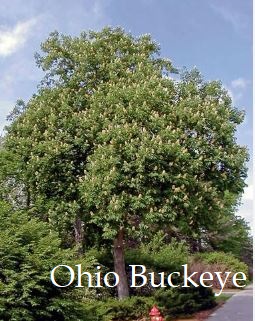
The Ohio Buckeye, scientifically called Aesculus glabra, is a impressive tree that is native to the country of Ohio. It is a favorite amongst both house owners and arborists due to its lovely splendor and adaptableness to Ohio’s weather.
One of the standout functions of the Ohio Buckeye is its foliage. During the spring and summer months, the tree is decorated with lush, dark green leaves that create a dense canopy. These leaves offer awesome coloration, making the Ohio Buckeye an excellent addition to any backyard or park.
Come autumn, the Ohio Buckeye places on a impressive display. Its leaves transform into a colourful array of colors, ranging from rich yellows and oranges to deep reds. This beautiful show of fall foliage is a sight to behold and provides a touch of herbal splendor to the Ohio landscape.
In addition to its visual attraction, the Ohio Buckeye additionally produces attractive vegetation within the spring. Clusters of small, pale yellow plant life bloom along the branches, creating a striking comparison towards the tree’s dark green foliage. These plant life not most effective add to the tree’s beauty however additionally function a precious source of nectar for pollinators like bees and butterflies.
Furthermore, the Ohio Buckeye is well-proper to Ohio’s weather. It is a hardy tree that may tolerate a wide variety of soil conditions, along with both dry and wet soils. It is also exceedingly proof against pests and illnesses, making it a low-upkeep alternative for house owners and landscapers.
When planting an Ohio Buckeye, it’s far critical to pick out a place that offers complete sun or partial colour. This tree flourishes in well-tired soil and benefits from ordinary watering, specially for the duration of dry spells. With proper care and protection, the Ohio Buckeye can come to be a majestic centerpiece in any Ohio landscape.
Whether you are trying to decorate the classy attraction of your home or make a contribution to the conservation of native Ohio bushes, the Ohio Buckeye is an exceptional choice. Its beautiful foliage, colorful flora, and flexibility to Ohio’s weather make it a top contender some of the pinnacle 10 bushes for thriving in Ohio.
Tree #2: Red Maple (Acer rubrum)
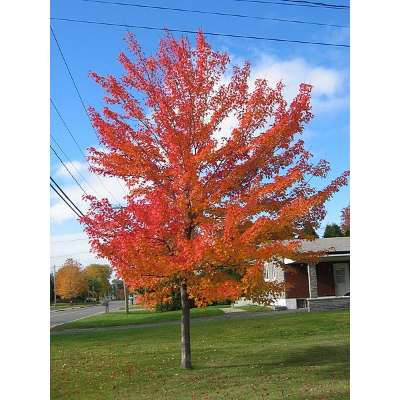
The Red Maple (Acer rubrum) is a beautiful tree that is well-perfect to thrive in Ohio’s weather. Known for its colourful pink foliage in the fall, this tree adds a burst of colour to any panorama. It is a fast-developing deciduous tree that can reach heights of as much as 60 feet, making it an terrific choice for imparting shade and privateness for your yard.
One of the important thing motives why the Red Maple flourishes in Ohio is its adaptability to diverse soil kinds. It can tolerate each moist and dry conditions, making it a versatile preference for owners. Additionally, this tree is fantastically low-preservation as soon as mounted, requiring minimal pruning or special care.
In the spring, the Red Maple produces clusters of small, red vegetation that entice pollinators which include bees and butterflies. As the seasons development, those plant life deliver manner to the tree’s characteristic winged seeds, also known as samaras, which twirl gracefully to the floor.
Apart from its aesthetic appeal, the Red Maple additionally offers practical benefits. Its dense foliage presents brilliant coloration at some point of the recent summer months, assisting to cool your out of doors residing areas and reduce electricity charges. Furthermore, this tree is understood for its robust timber, making it proof against wind damage.
When planting a Red Maple, it is important to choose a area that receives complete to partial daylight. Ensure that the soil is properly-tired to prevent waterlogging, as immoderate moisture can lead to root rot. With right care and upkeep, the Red Maple can thrive for decades, making it a valuable addition to any Ohio landscape.
In conclusion, the Red Maple (Acer rubrum) is a top preference for Ohio homeowners searching for a tree that could withstand the nation’s weather. Its lovely crimson foliage, adaptability to distinct soil sorts, low-upkeep nature, and realistic benefits make it a worthy addition to any backyard or lawn. Consider planting a Red Maple and revel in its splendor and resilience for years yet to come.
Tree #three: White Oak (Quercus alba)
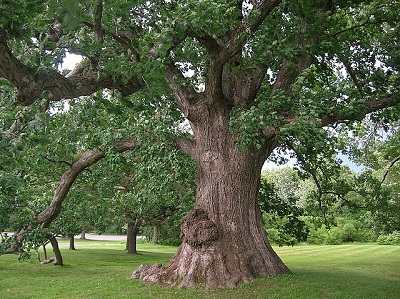
When it involves timber that thrive in Ohio’s weather, the White Oak (Quercus alba) is surely one of the top choices. With its majestic stature and stunning look, this tree is a fave amongst owners, landscapers, and nature fans alike.
The White Oak is a deciduous tree which can attain amazing heights of up to 80 toes, with a range of 50 to 80 ft. Its huge, spreading branches create a lovely cover that provides ample colour at some stage in the recent summer time months. The leaves of the White Oak are different, with their lobed shape and deep green colour, which turns a colourful pink inside the fall.
One of the reasons why the White Oak is so nicely-appropriate to Ohio’s climate is its tolerance for a wide variety of soil kinds. It can adapt to both dry and wet soils, making it a versatile preference for diverse landscapes. Additionally, this tree is thought for its sturdy and strong timber, making it proof against wind and ice damage, which are common in Ohio.
The White Oak also plays a vital role in assisting nearby flora and fauna. Its acorns function a important food source for lots animals, inclusive of deer, squirrels, and birds. The tree’s sprawling branches offer top notch nesting sites for birds, while its dense foliage offers safe haven and safety for diverse flora and fauna species.
If you are considering planting a White Oak on your Ohio landscape, it is critical to select a sunny place with well-draining soil. This tree prefers complete solar or partial coloration, and once installed, it requires minimum preservation. Regular watering all through dry spells and occasional pruning to put off lifeless or broken branches will assist make certain its healthful boom.
In end, the White Oak is a astonishing tree that prospers in Ohio’s climate. Its striking look, adaptability, and ecological value make it an brilliant choice for owners and nature lovers trying to enhance their landscapes while supporting nearby natural world. Consider including this majestic tree in your out of doors space and experience the severa blessings it brings.
Tree #4: Sassafras (Sassafras albidum)
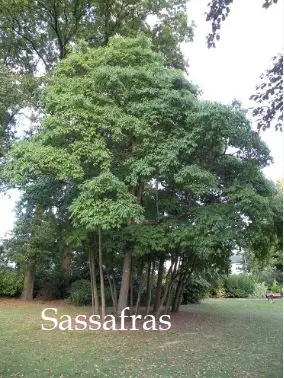
The Sassafras tree, scientifically referred to as Sassafras albidum, is a visually beautiful and flexible tree that thrives in Ohio’s climate. This deciduous tree can reach heights of as much as 60 ft and has a completely unique look that adds charm to any panorama.
One of the most one-of-a-kind capabilities of the Sassafras tree is its leaves. They are fashioned like mittens or 3-pronged forks, making them without difficulty recognizable. In the spring, the leaves emerge a vibrant green, transforming into sunglasses of yellow, orange, and red within the fall, creating a breathtaking show of colors.
Apart from its aesthetic attraction, the Sassafras tree has a rich history and cultural importance. It has been used for centuries for each culinary and medicinal purposes. The aromatic bark of the Sassafras tree has been used to make teas, infusions, and root beer, infusing a unique and pleasant taste. Additionally, the leaves were used in traditional medication for diverse illnesses.
In terms of developing situations, the Sassafras tree is adaptable and might thrive in a extensive range of soil sorts. It prefers properly-tired soil but can tolerate each wet and dry situations. It is also extraordinarily resistant to pests and sicknesses, making it a low-renovation preference for house owners and landscapers.
When planting a Sassafras tree, it’s far advocated to choose a area that offers partial shade, as excessive exposure to direct daylight can cause leaf sizzling. Additionally, everyday watering at some stage in the initial years will assist establish a robust root machine.
Whether you are seeking to beautify your outside or create an inviting streetscape, the Sassafras tree is an exquisite preference. Its precise look, vibrant shades, and cultural importance make it a standout tree on the way to thrive in Ohio’s weather.
Tree #five: American Hornbeam (Carpinus caroliniana)

The American Hornbeam, additionally referred to as Carpinus caroliniana, is a versatile and resilient tree that flourishes inside the numerous weather of Ohio. With its specific characteristics and adaptability, it has turn out to be a popular desire for both residential and business landscapes.
One of the standout features of the American Hornbeam is its putting look. Its clean, grayish bark resembles the musculature of a flexed arm, earning it the nickname “musclewood.” This different bark adds visual hobby and texture to any landscape, specifically for the duration of the iciness months whilst other timber might also seem bare and stupid.
In phrases of size, the American Hornbeam is considered a medium-sized tree, normally attaining heights of 20 to 40 toes. Its compact and rounded canopy provides sufficient colour, making it a exquisite addition to outdoor areas along with parks, gardens, and even city regions where area may be limited.
When it comes to Ohio’s climate, the American Hornbeam is nicely-suitable to address the place’s challenges. It is thought for its tolerance to a wide variety of soil conditions, including clay and loam. Additionally, it may resist each full sun and partial color, making it adaptable to various lights situations.
Another gain of the American Hornbeam is its potential to withstand harsh weather situations. It is a hardy tree that could undergo strong winds, heavy snow fall, or even ice storms. This resilience makes it a dependable desire for Ohio’s unpredictable climate styles.
Beyond its durability, the American Hornbeam also gives ecological benefits. Its foliage serves as a meals source for diverse insects, birds, and small mammals, contributing to the overall biodiversity of the region. Additionally, its dense branching shape gives nesting web sites and safe haven for natural world.
In phrases of preservation, the American Hornbeam is exceptionally low-upkeep as soon as installed. Regular watering at some stage in the primary few years is vital for its a success establishment. However, it usually calls for minimal pruning or special care, making it a wonderful preference for those seeking a tree that might not demand excessive effort and time.
Whether you’re trying to enhance your outdoor, create a shaded retreat, or add splendor to a public space, the American Hornbeam is a top preference amongst Ohio’s bushes. Its particular appearance, adaptability, and resilience make it an exceptional addition to any landscape, imparting lengthy-time period leisure and aesthetic appeal.
Tree #6: Eastern Redbud (Cercis canadensis)
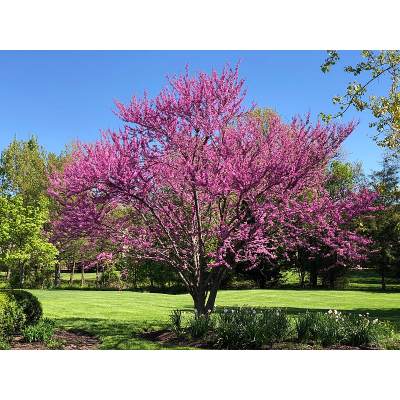
One of the top bushes that thrive in Ohio’s climate is the Eastern Redbud (Cercis canadensis). Known for its beautiful show of purple and pink plants inside the spring, this tree adds a colourful burst of colour to any panorama. The Eastern Redbud is a small to medium-sized tree, commonly reaching a peak of 20 to 30 toes.
One of the motives why the Eastern Redbud is a popular preference amongst Ohio gardeners is its adaptability to diverse soil types. It can tolerate both acidic and alkaline soils, making it appropriate for a wide variety of places throughout the country. Additionally, this tree is exceptionally low-maintenance, making it a really perfect choice for owners who need to feature beauty to their outdoor spaces without the trouble of sizeable renovation.
In addition to its attractive plant life, the Eastern Redbud additionally boasts heart-shaped leaves that flip a vibrant yellow within the fall, including any other layer of visual interest. It is a deciduous tree, dropping its leaves in the winter, making an allowance for lots of daylight to attain the ground for the duration of the chillier months.
Not only is the Eastern Redbud aesthetically beautiful, however it additionally serves as a treasured habitat for diverse flora and fauna. Its flowers attract bees and butterflies, even as its branches offer nesting web sites for birds. This tree really enhances the ecological stability of any environment it’s far planted in.
When selecting a place to plant the Eastern Redbud, it’s far crucial to choose a place that receives complete to partial daylight. This tree prefers well-tired soils but can tolerate periods of drought as soon as hooked up. It is suggested to offer ordinary watering in the course of the primary few years of boom to ensure its healthy established order.
Overall, the Eastern Redbud is a top preference for Ohio gardeners seeking to upload beauty, color, and ecological fee to their landscapes. With its stunning flowers, attractive foliage, and flexibility to Ohio’s climate, this tree is a true standout in any outside placing.
Tree #7: Kentucky Coffeetree (Gymnocladus dioicus)
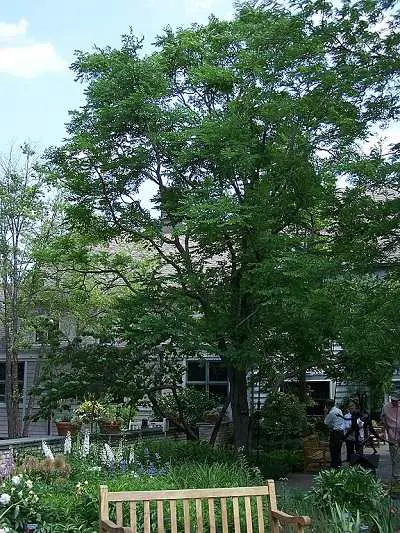
The Kentucky Coffeetree, scientifically referred to as Gymnocladus dioicus, is a outstanding tree that prospers in Ohio’s weather. Native to the place, this deciduous tree is famend for its unique look and outstanding characteristics.
One of the maximum striking capabilities of the Kentucky Coffeetree is its massive, compound leaves that can measure up to two ft in length. These leaves offer ample coloration all through the hot summer time months, making it a super addition to any panorama or outside. The leaves additionally turn a colourful yellow coloration in the fall, adding a touch of autumnal splendor to the surroundings.
But what simply units the Kentucky Coffeetree aside is its decorative price. In the spring, it produces clusters of aromatic, greenish-white vegetation that add a satisfying fragrance to the air. After the flora fade, long, dark brown seed pods take their location, giving the tree an interesting visible enchantment.
Despite its name, the Kentucky Coffeetree does now not produce real espresso beans. However, Native Americans and early settlers used the roasted seeds as a coffee replacement, therefore the name. It is really worth noting that the seeds are toxic and need to not be ate up.
In terms of boom, the Kentucky Coffeetree is known for its hardiness and flexibility. It can resist a wide variety of soil kinds, which include clay, loam, and sand, and is tolerant of city conditions. This makes it an extremely good desire for city environments or areas with less-than-perfect soil conditions.
When fully mature, the Kentucky Coffeetree can attain a peak of 60 to 75 ft with a variety of 40 to 50 toes, developing an impressive canopy that gives shade and refuge for wildlife. Its strong branches make it a strong desire even for the duration of storms, making sure its toughness within the panorama.
Overall, the Kentucky Coffeetree is a visually beautiful and resilient tree that prospers in Ohio’s weather. Its particular look, fragrant vegetation, and flexibility to numerous soil sorts make it an notable choice for any Ohioan looking to beautify their panorama with a native tree.
Tree #eight: Pawpaw (Asimina triloba)

Tree #eight on our listing of the top 10 bushes for thriving in Ohio’s weather is the Pawpaw (Asimina triloba). This particular and versatile tree is local to the eastern United States, including Ohio, and is understood for its scrumptious fruit and exquisite foliage.
The Pawpaw tree is a small to medium-sized tree which can reach heights of as much as 30 feet. It has huge, tropical-looking leaves that turn a colourful yellow inside the fall, adding a burst of shade to the landscape. The tree also produces pink plants within the spring, which are accompanied via greenish-yellow end result that resemble small bananas.
One of the main motives why the Pawpaw tree is so popular in Ohio is its capability to thrive in a variety of soil types. It can tolerate both clay and sandy soils, making it a flexible preference for homeowners and landscapers alike. Additionally, the Pawpaw tree is adaptable to distinct mild situations, although it prefers partial coloration to full sun.
Another appealing issue of the Pawpaw tree is its fruit. Pawpaw fruits are candy and custard-like, with a taste frequently compared to a mixture of banana, mango, and melon. They are a favorite among locals and can be used in a number of culinary creations, from pies and ice creams to smoothies and jams.
In phrases of care, the Pawpaw tree calls for normal watering, specifically all through dry intervals. It is also recommended to mulch around the base of the tree to help maintain moisture and suppress weed increase. Pruning is usually not important, besides to cast off lifeless or damaged branches.
If you are looking for a unique and flavorful addition for your Ohio panorama, the Pawpaw tree is certainly well worth thinking about. Its appealing foliage, beautiful plants, and delicious fruit make it a standout choice for any lawn or backyard.
Tree #nine: Northern Catalpa (Catalpa speciosa)
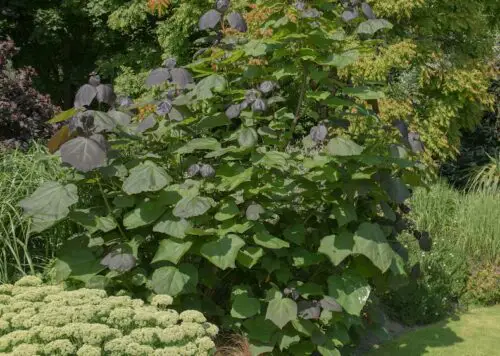
Tree #9 on our list of top bushes for thriving in Ohio’s weather is the wonderful Northern Catalpa (Catalpa speciosa). Native to the Midwest, this deciduous tree boasts beautiful features that make it a standout choice for any Ohio panorama.
One of the most distinguishing characteristics of the Northern Catalpa is its huge, heart-fashioned leaves. These leaves create a lovely cover that offers ample coloration in the course of warm summer months, making it an ideal addition to any outside or park putting.
In addition to its aesthetic attraction, the Northern Catalpa is thought for its specific and showy flowers. From late spring to early summer, the tree produces clusters of trumpet-fashioned, white vegetation with pink and yellow markings. These blossoms now not simplest upload a touch of beauty to the panorama but additionally entice pollinators such as bees and butterflies.
Another first rate characteristic of the Northern Catalpa is its fruit. As summer season progresses, the tree develops lengthy, cylindrical seedpods which could attain up to twenty inches in duration. These pods aren’t simplest visually fascinating however also function a source of meals for flora and fauna, which include squirrels and birds.
Furthermore, the Northern Catalpa is surprisingly adaptable and may thrive in numerous soil situations, inclusive of clay and loam. It is likewise tolerant of drought, making it a resilient desire for Ohio’s unpredictable climate styles.
When fully matured, the Northern Catalpa can attain a peak of forty to 60 ft, making it an excellent addition to any landscape. Its spreading branches create a extensive and rounded crown, adding to its average grandeur.
Whether you are looking to beautify your backyard oasis, create a shaded area for rest, or entice natural world to your house, the Northern Catalpa is a super preference. Its putting capabilities, adaptability, and resilience make it one of the pinnacle timber for thriving in Ohio’s weather.
Tree #10: Black Cherry (Prunus serotina)
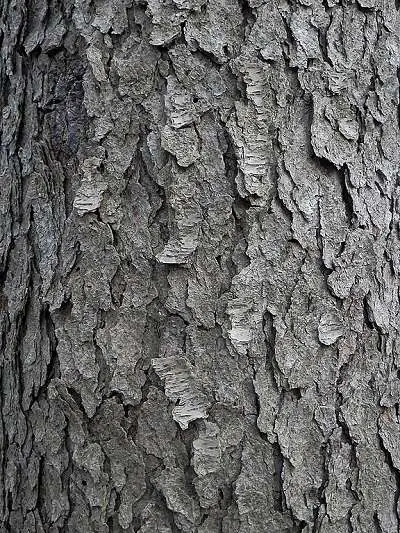
The Black Cherry, scientifically called Prunus serotina, is a terrific tree that thrives in Ohio’s climate. As the tenth tree in our remaining manual, it brings a unique set of traits and blessings to any landscape.
One of the most placing functions of the Black Cherry is its stunning foliage. During spring and summer season, its leaves show off a colourful green color, growing a lush and alluring cover. In the fall, those leaves remodel right into a captivating show of reds, oranges, and yellows, adding a burst of coloration to the autumn landscape.
But the splendor of the Black Cherry does not forestall at its leaves. This tree additionally produces clusters of small, white vegetation in the spring, which offer manner to darkish, juicy cherries in the summer. These cherries aren’t best visually appealing but also appeal to a number of wildlife, such as birds and small mammals.
Furthermore, the Black Cherry is known for its resilience and flexibility. It can tolerate a extensive range of soils, from clay to loam, and may thrive in both complete solar and partial color. This makes it an outstanding desire for Ohio’s numerous climate, wherein it may face up to harsh winters and hot summers with ease.
In addition to its aesthetic enchantment and adaptability, the Black Cherry additionally performs a crucial role in Ohio’s surroundings. It provides meals and refuge for numerous flora and fauna species, contributes to soil stabilization, and even acts as a number plant for numerous butterfly species.
When planting a Black Cherry tree, it’s essential to offer it enough area to develop, as it could reach heights of up to 80 ft. Proper pruning and preservation will make certain its longevity and sell a healthful, nicely-formed tree.
Whether you are seeking to enhance the visible attraction of your landscape, appeal to natural world, or contribute to the ecological stability of Ohio, the Black Cherry is an incredible preference. Its beautiful foliage, pleasant cherries, and adaptability make it a pinnacle contender for anybody looking for a thriving tree in Ohio’s climate.
Tips for a success tree planting and care in Ohio
Planting and being concerned for trees in Ohio requires cautious consideration of the climate and particular needs of various tree species. To make certain successful growth and longevity, here are some key hints to observe:
1. Choose the right tree: Select species which might be well-appropriate to Ohio’s climate and soil situations. Some popular picks consist of the Red Maple, White Oak, American Beech, and Eastern Redbud. Research the specific necessities of every tree to ensure compatibility along with your region.
2. Plant at the proper time: The great time to plant timber in Ohio is in the course of the dormant season, normally in past due fall or early spring. This allows the tree to set up its root system before going through harsh climate situations or extreme temperatures.
Three. Prepare the planting website online: Ensure the place is free from weeds, grass, and competing flowers. Dig a hole that is huge and shallow, allowing the roots to unfold out effortlessly. Loosen the soil and amend it with organic matter to sell right drainage and nutrient availability.
4. Proper spacing: Consider the mature size of the tree and go away sufficient area among each tree to allow for healthy increase and proper air circulate. This prevents overcrowding and decreases the threat of diseases and pests.
Five. Watering: Newly planted timber require normal watering to promote root established order. Water deeply and infrequently, ensuring the water reaches the tree’s root quarter. Avoid overwatering, as it is able to cause root rot and different troubles.
6. Mulching: Apply a layer of natural mulch across the base of the tree, leaving a few inches of area around the trunk to prevent moisture buildup and potential pests. Mulch facilitates hold soil moisture, alter temperature, and suppress weed increase.
7. Pruning: Prune trees often to put off dead or broken branches, improve structure, and preserve usual health. Pruning in overdue winter or early spring is suggested when the tree continues to be dormant.
8. Fertilization: Conduct a soil test to decide in case your tree requires additional vitamins. Fertilize as wanted, following advocated pointers and averting excessive use, which can harm the tree and surrounding environment.
9. Pest and disorder management: Monitor your bushes for symptoms of pests or sicknesses and take suitable action right away. Contact local arborists or extension services for identification and remedy suggestions.
10. Winter protection: Ohio’s winters can be harsh, so protect young or vulnerable trees from intense temperatures, ice, and snow. Install tree wraps or burlap covers to guard the trunk and branches.
By following those suggestions for a hit tree planting and care in Ohio, you can make certain that your trees thrive, beautify your panorama, and make a contribution to a more fit surroundings. Remember, persistence and consistent preservation are key elements inside the long-term achievement of your bushes.
Final thoughts on choosing timber for Ohio’s weather
In conclusion, choosing the right trees for Ohio’s climate is vital for their lengthy-time period survival and thriving. By thinking about elements consisting of hardiness zones, soil conditions, and weather styles, you may make certain that the bushes you pick out are properly-proper to the particular situations of the location.
Throughout this manual, we have explored the pinnacle 10 timber which have proven to be resilient and a success in Ohio’s weather. From the stately all righttrees to the colourful dogwoods, every tree offers its particular beauty and benefits to the landscape.
Remember, it is vital to analyze and apprehend the particular desires of every tree species earlier than creating a final decision. Taking under consideration elements such as daylight requirements, soil pH, and water wishes will help you are making an informed desire as a way to promote healthful increase and longevity.
Additionally, recall to recall the favored cause and characteristic of the trees to your landscape. Are you looking for shade trees, decorative timber, or trees that provide habitat for natural world? Aligning your tree selection with your landscaping dreams will enhance the overall aesthetic attraction and capability of your outdoor area.
Lastly, continually seek advice from local professionals, consisting of arborists or horticulturists, who possess large expertise of Ohio’s climate and can offer precious insights and hints. Their knowledge will make sure which you make the high-quality selections in your precise place and situations.
